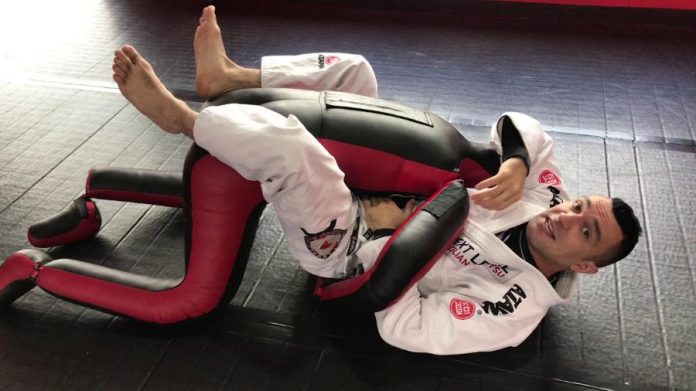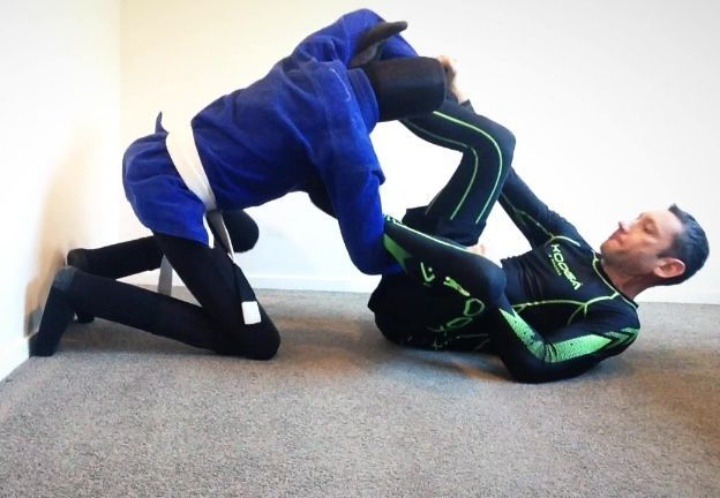
Gyms are slowly starting to reopen their doors for BJJ training. During such time, though, and according to local government guidelines, some academies will employ non-contact training, at least at the beginning. It does not make much sense, to train Jiu-Jitsu without contact, but in reality, it is not exactly so. Non-contact training means you’ll be using a grappling dummy to train, instead of a live partner. That said, training with a grappling dummy can be awkward, especially if you’ve never done it before.
Grappling dummies play a big role in wrestling training. In fact, dummies might just exist because of wrestling in the first place. Anyhow, training with a grappling dummy can be really beneficial for Jiu-Jitsu. It can never replace full-blown partner training, but it might just be the next best thing until we can relax a bit more with the restrictive measures. Still, even with a dummy, you need to know what you’re doing, in order to really get something out of training. Moreover, if you don’t have a grappling dummy, you’ll find a useful guide to making one at the end of this article.
How Far Can A Grappling Dummy Take You?
With a grappling dummy, you can work on two main aspects of your Jiu-Jitsu game. The first one is a specific movement, and it depends on the type of dummy you’re using. The second is specific conditioning, doing physical drills by using the grappling dummy more as weight than a substitute partner.

Now, you won’t’ really be able to learn anything new, at least not in a realistic way when your “partner” is not moving, shifting weight, and resisting more or less. However, you will be able to really fortify positions and techniques you already know. The limbs really come in handy here, as you can greatly improve leg locking and arm locking positioning using a grappling dummy. You might fall short on any real guard work, as you can’t drill too many things form the bottom with a dummy, but your top game will certainly be on fire. Since passing guards also makes little sense without resistance, go for pressure, and the feel of transitioning without leaving any space.
Training With Grappling Dummies
Now, people might say that training with a grappling dummy is a waste of time. To be honest, it is like learning to surf without going into the water, but given the current situation, it is much better than doing nothing at all.
The most important thing to know when setting up grappling dummy drills is managing expectations. Instead of looking for fast-paced action, focus on the details of every move you perform. To that extent, try to mimic a roll as much as you can. Every gym that has no-contact training probably has a curriculum repapered with what you can train. However, if you have the freedom to have fun, mimic a match. Start standing and do as many takedown drills as you can. From there on proceed to guard passing drills, before looking to establish side control. Even better, if you can, train half guard first. Continue through all top positions to mount. Use the Gi to train some chokes, and of course drill armbars on both sides.
Then, get up, and mimic pulling guard. From the bottom, you won’t have many options but you can still put in reps on chokes, armlocks, some sweep motions, and eventually, go for the back to work on some more chokes.
In terms of using a grappling dummy for conditioning, think standing. It doesn’t have to be only takedowns. You can lift the dummy on each shoulder, you can suplex it, you can turn it upside down, hip throws it… Also, going for knee on belly transitions left to right, or speed passing, and even hip bumps can be a great way to increase your cardio before live rolling is back on the schedule.
Make Your Own Grappling Dummy
Now, let’s look at how you can make a grappling dummy out of practically nothing. All you need is a spare Gi, and some stuff you surely have lying around your house. In fact, the equipment you need is as follows; A GI jacket, a belt, three towels (regular sized ones), three pillows (also regular sized) a blanket, and a winter coat that zips all the way up.
Simply stack the pillows on top of each other, and cover tightly with the blanket. Now, slide a towel in each of the winter coat’s sleeves, and use the third one to connect the other two from the inside. Place the wrapped pillows in the middle and zip the coat up. Finally, put the Gi jacket over the coat, and tie the belt. There are other options as well that include building a grappling dummy with legs. All you have to do is a little online research.
All In All
Training with a grappling dummy can be fun. It also gets boring really quickly unless you change things up. Hopefully, your gym will have a curriculum for non-contact training that will provide variety. If not, make sure you cycle through different drills, both technical and conditioning ones. Also, if you’re making your own grappling dummy, then make sure you make it in a form that will help you drill your own game. Or just buy one of the best.


![Darce Choke Encyclopedia – Origins, Mechanics and Variations [2025] BJJ, choke, Brabo, BJJ Darce Choke, D'arce Choke, Darce BJJ Choke](https://bjj-world.com/wp-content/uploads/2017/11/JungPoirierLeeYahoo-218x150.jpg)










![Leg Locks Finishes Helena Crevar DVD Review [2025] Leg Locks Finishes Helena Crevar DVD Review](https://bjj-world.com/wp-content/uploads/2025/04/leg-locks-finishes-helena-crevar-dvd-review-218x150.png)


![Leg Entanglement System: X Lock Owen Jones DVD Review [2025] Leg Entanglement System: X Lock Owen Jones DVD Review](https://bjj-world.com/wp-content/uploads/2025/04/leg-entanglement-system-x-lock-owen-jones-dvd-review-218x150.png)
![[WATCH] John Wick Invitational 2 Delivers Viral Suit-Jitsu Spectacle [WATCH] John Wick Invitational 2 Delivers Viral Suit-Jitsu Spectacle](https://bjj-world.com/wp-content/uploads/2025/04/john-wick-invitational-2-suit-jitsu-spectacle-218x150.png)
![Defensive Wrestling for Jiu-Jitsu Pat Downey DVD Review [2025] Defensive Wrestling for Jiu-Jitsu Pat Downey DVD Review](https://bjj-world.com/wp-content/uploads/2025/04/defensive-wrestling-for-jiu-jitsu-pat-downey-dvd-review-218x150.png)
![Total Domination Top Control Mariusz Domasat DVD Review [2024] Total Domination Top Control Mariusz Domasat DVD Review](https://bjj-world.com/wp-content/uploads/2024/09/domination-top-control-mariusz-domasat-dvd-review-324x235.png)


![Zen Guide To Submission Grappling Margot Ciccarelli DVD Review [2025] Zen Guide To Submission Grappling Margot Ciccarelli DVD Review](https://bjj-world.com/wp-content/uploads/2025/02/submission-grappling-margot-ciccarelli-dvd-preview-100x70.png)
![Weight Training For Grappling Michael Israetel DVD Review [2025] Weight Training For Grappling Michael Israetel DVD Review](https://bjj-world.com/wp-content/uploads/2025/01/weight-training-for-grappling-michael-israetel-dvd-review-100x70.png)

![Woj Lock the World Chris Wojcik Ankle Locks DVD Review [2024] Woj Lock the World Chris Wojcik Ankle Locks DVD Review](https://bjj-world.com/wp-content/uploads/2024/12/woj-lock-the-world-chris-wojcik-dvd-review-100x70.png)
![Slip N Slide Into Victory Julián Espinosa DVD Review [2025] Slip N Slide Into Victory Julián Espinosa DVD Review](https://bjj-world.com/wp-content/uploads/2025/01/slip-n-slide-into-victory-julian-espinosa-dvd-review-100x70.png)

![Master The Move The American Lock John Danaher DVD Review [2024] Master The Move The American Lock John Danaher DVD Review](https://bjj-world.com/wp-content/uploads/2024/12/the-american-lock-john-danaher-dvd-review-100x70.png)

![Advanced Chin Control Concepts David Petrone DVD Review [2025] Advanced Chin Control Concepts David Petrone DVD Review](https://bjj-world.com/wp-content/uploads/2025/01/chin-control-concepts-david-petrone-dvd-review-100x70.png)
![Dubious De La Riva Dominique Bell DVD Review [2024] Dubious De La Riva Dominique Bell DVD Review](https://bjj-world.com/wp-content/uploads/2024/10/dubious-de-la-riva-dominique-bell-dvd-review-100x70.png)

![Giancarlo Bodoni DVD Bundle Essential Connections Full Review [2024] Giancarlo Bodoni DVD Bundle Essential Connections Full Review](https://bjj-world.com/wp-content/uploads/2024/09/giancarlo-bodoni-dvd-bundle-essential-connections-100x70.png)

![Ginastica Natural Alvaro Romano DVD Review [2024] Ginastica Natural Alvaro Romano DVD Review](https://bjj-world.com/wp-content/uploads/2024/12/ginastica-natural-alvaro-romano-dvd-review-100x70.png)


![Higher Tripod Passing Craig Jones DVD Review [2025] Higher Tripod Passing Craig Jones DVD Review](https://bjj-world.com/wp-content/uploads/2025/02/higher-tripod-passing-craig-jones-dvd-review-100x70.png)
![Defensive Wrestling for Jiu-Jitsu Pat Downey DVD Review [2025] Defensive Wrestling for Jiu-Jitsu Pat Downey DVD Review](https://bjj-world.com/wp-content/uploads/2025/04/defensive-wrestling-for-jiu-jitsu-pat-downey-dvd-review-100x70.png)
![Leg Locks Finishes Helena Crevar DVD Review [2025] Leg Locks Finishes Helena Crevar DVD Review](https://bjj-world.com/wp-content/uploads/2025/04/leg-locks-finishes-helena-crevar-dvd-review-100x70.png)
![360 Degrees Guard Retention Thiago Abud DVD Review [2024] 360 Degrees Guard Retention Thiago Abud DVD Review](https://bjj-world.com/wp-content/uploads/2024/10/360-degrees-guard-retention-thiago-abud-dvd-review-100x70.png)
![Master Scissor Sweep Ryan Scialoia DVD Review [2025] Master Scissor Sweep Ryan Scialoia DVD Review](https://bjj-world.com/wp-content/uploads/2024/12/scissor-sweep-ryan-scialoia-dvd-review-100x70.png)
![Reverse Arm Bar System Andrew Kerfoot DVD Review [2024] Reverse Arm Bar System Andrew Kerfoot DVD Review](https://bjj-world.com/wp-content/uploads/2024/10/reverse-arm-bar-system-andrew-kerfoot-dvd-review-100x70.png)

![Intro To Hip Mobility for Guard Players Joshua Presley DVD Review [2024] Intro To Hip Mobility for Guard Players Joshua Presley DVD Review](https://bjj-world.com/wp-content/uploads/2024/09/hip-mobility-for-guard-joshua-presley-dvd-review-100x70.png)
![Ultimate Study Tomoe Nage Neil Adams BJJ DVD Review [2025] Ultimate Study Tomoe Nage Neil Adams BJJ DVD Review](https://bjj-world.com/wp-content/uploads/2025/04/tomoe-nage-neil-adams-bjj-dvd-review-100x70.png)